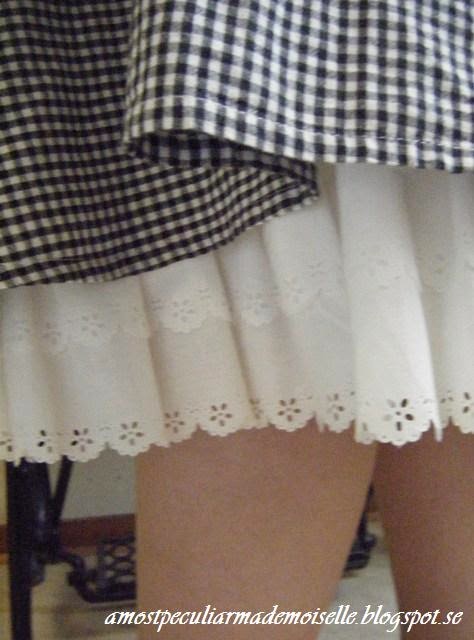I am always on the
lookout for fabrics and other things that will fit projects I’m working on or
am planning. As I have had a very narrow income for most of my life, I’ve got
in the habit of waiting for a thing to show up at a price I can justify, rather
than getting what I want when I want it, or accepting poor alternatives. This
is especially true of periods I don’t commit fully to at the moment. It’s not
an ideal way to go about costuming, as it can take years - decades even - to
stumble on the right things, but what can you do if you’re a poor perfectionist...
Fabrics for women’s
clothing during the 19th century (lower to middle class) is one of
those things I’m always looking for, and smallish checked tablecloths can be
very good to pick up, as they are often of the right size (ca. 70-100 cm
depending on the year) and often have woven in borders that were typical
of head- and neckerchiefs.
This is how you see them worn all over the country,
but there were also other, more regional styles.
Simple checked kerchiefs
were worn by all ordinary women, as the wearing of hats and bonnets were often
looked upon as dressing above one’s station. The group pressure in the
countryside was severe enough in many places that this informal rule was
usually adhered to right through the century and into the next. In towns and
cities it was less rigid, but many couldn’t afford other headwear than
kerchiefs anyway. There were other kinds of kerchiefs as well, but I won’t go
into that in this post.
How these checked kerchiefs looked changed over the 19th century. In the early years they were made from linen, with blue, yellow and/or red checks on a white base. As the century wore on they were often made from linen/cotton and then cotton. Darker shades, often with red and light blue checks on a dark blue base, appeared. The season also affected the colours: lighter colours were worn in the summer and darker colours in the winter. Sometimes you see two kinds of borders on the same kerchief, so when folded into a triangle, depending on what half you showed off, it would be proper for different occasions, one often being simpler and the other brighter, or more elaborate.
These kerchiefs were
often woven at home, sometimes in greater quantities, to be sold on by the
weaver, or, more often, by peddlers. In some parts of the country it became
tradition for brides-to-be to weave kerchiefs for their friends.
This one I got for a
small price at a charity shop a few years ago. The colours and border look
enough like period kerchiefs to make me quite glad I found it. I cut of the
tied fringes, and hemmed the square by hand with blue linen thread, just like in
some originals.
Tada! a finished challenge. In the pictures I’m wearing it with
the Insanely Pieced Dress.
This style is seen in the county Skåne (Scania), alongside the other.
The Challenge: #2 Blue
Fabric: Cotton
Pattern: none
Year: About mid to late 19th century
Notions: Linen thread
How historically accurate is it? Pretty much.
Hours to complete: About two.
First worn: For the pictures
Total cost: Between 10-30 SEK ($1,19-3,57; £0,77-2,32; €1,04-3,13), for the
fabric I think, and a little
more for the thread, though that came from stash.
References:
Eldvik, B. Möte med Mode - folkliga kläder
1750-1900 i Nordiska Museet. Stockholm: Nordiska Museets Förlag.


.%2BNationalmuseum%2C%2Bnr.%2BNMH%2B2311906.jpg)






